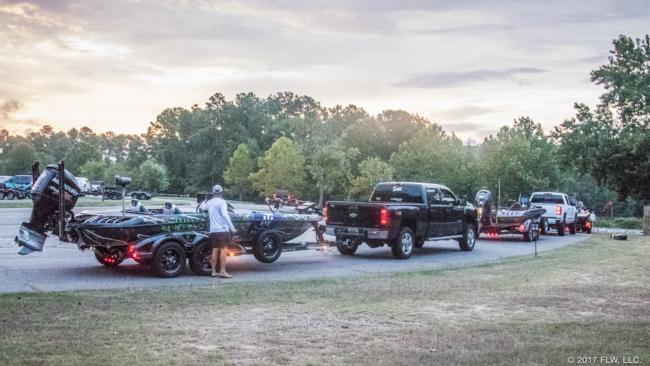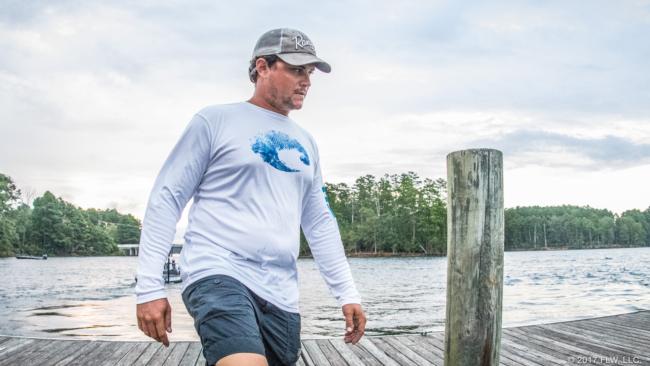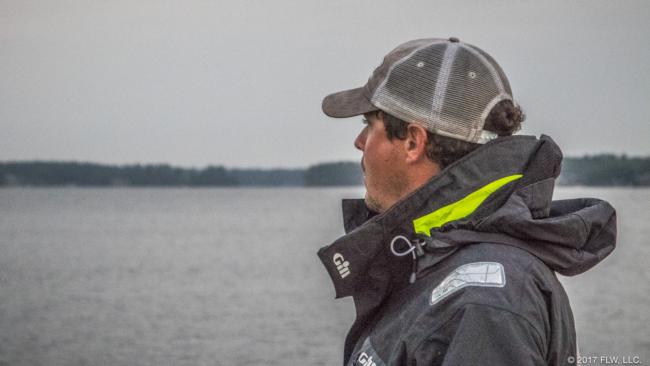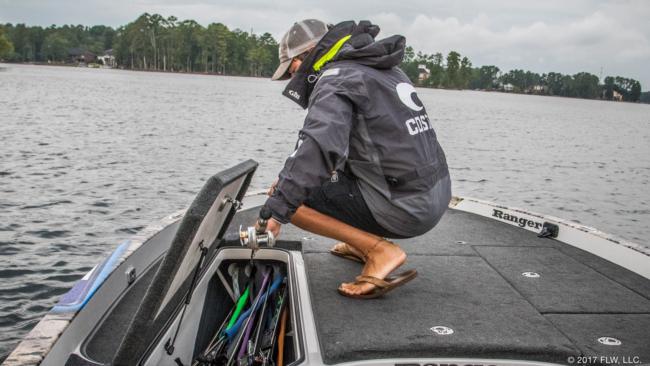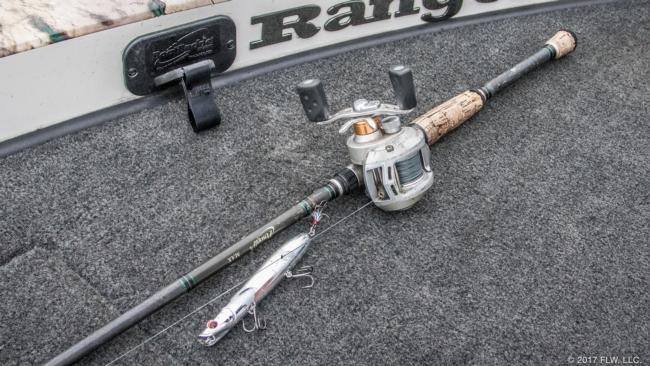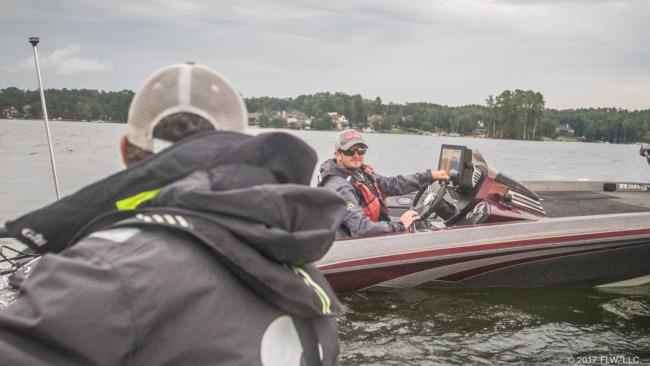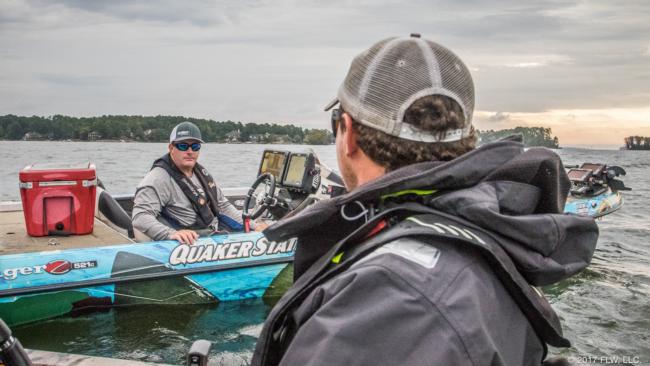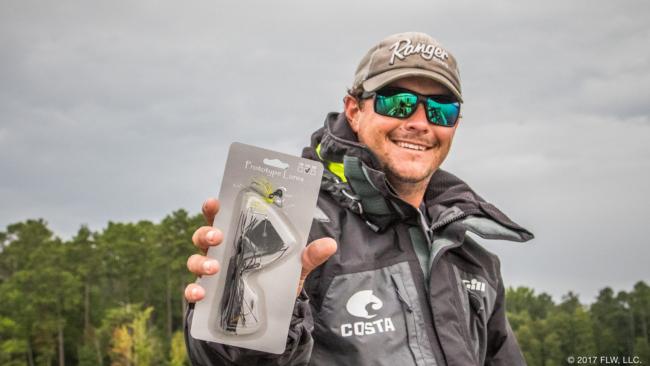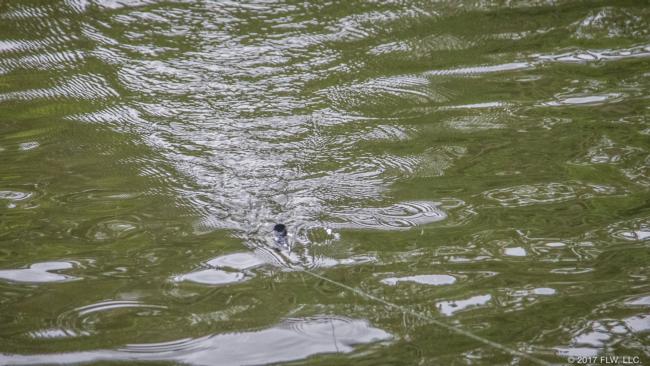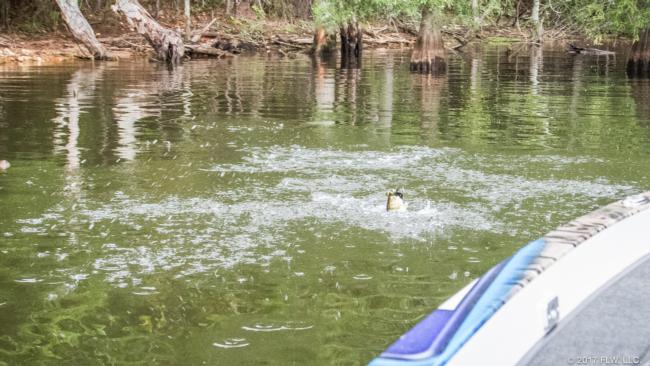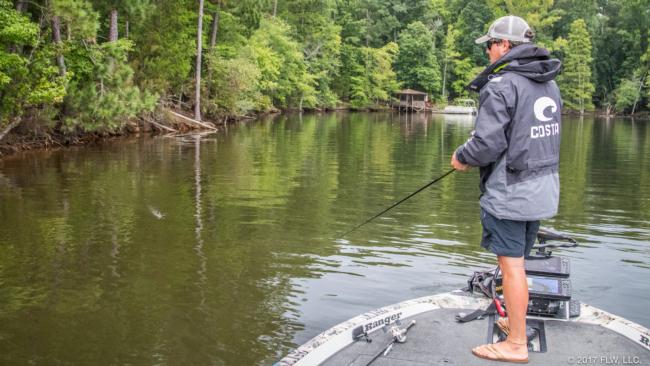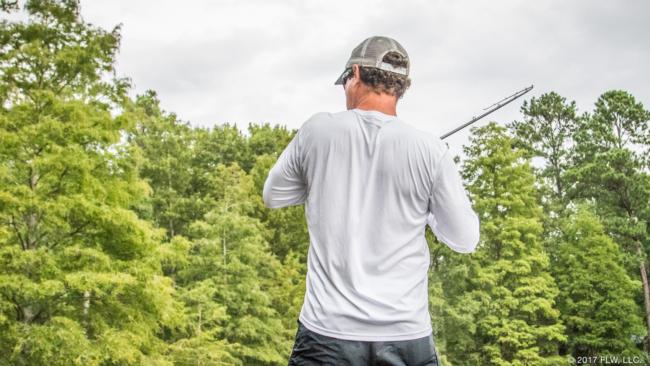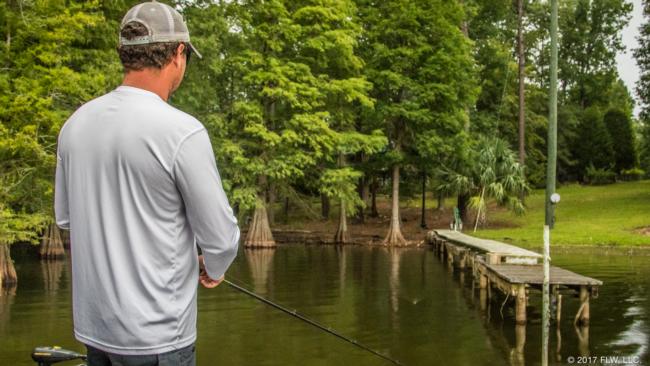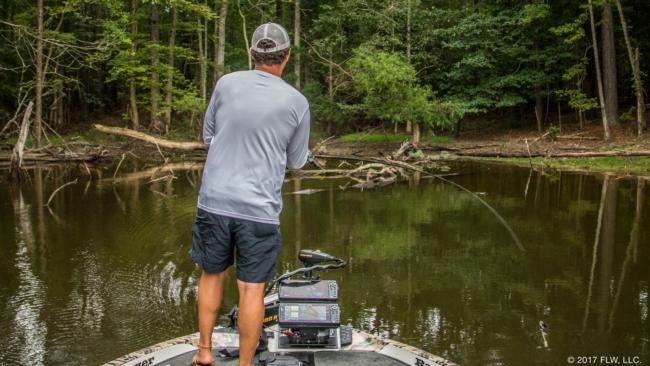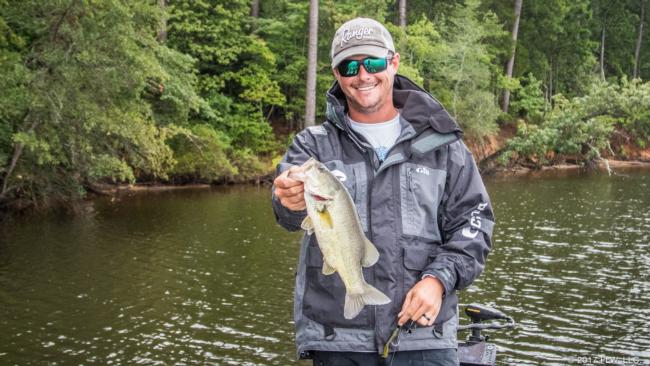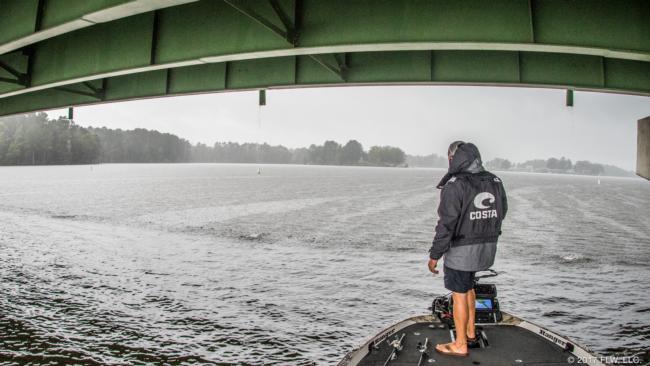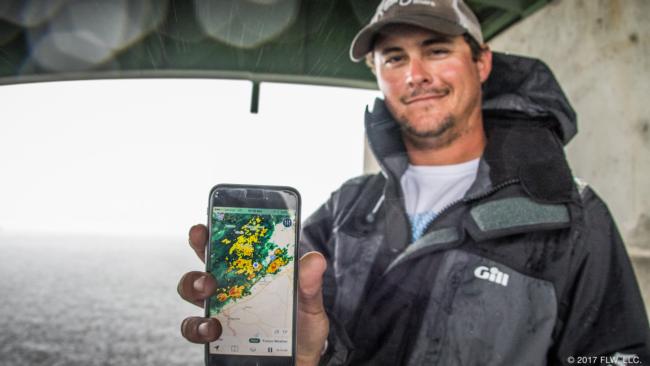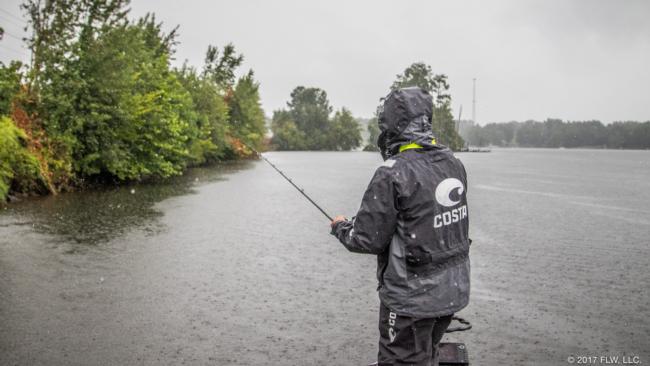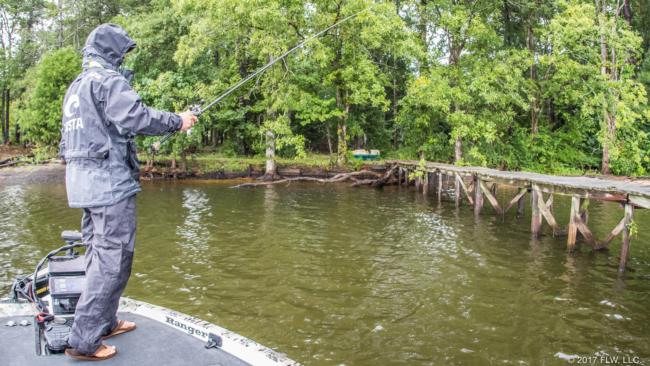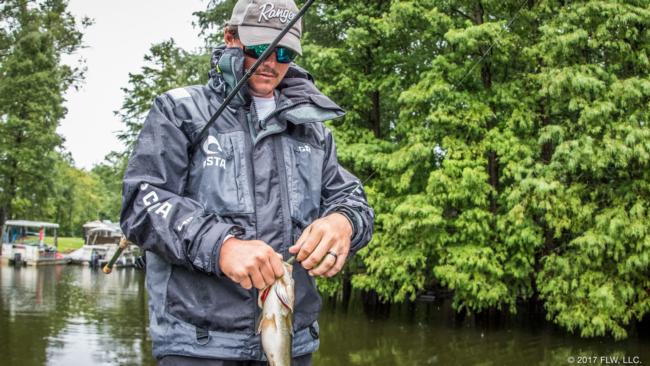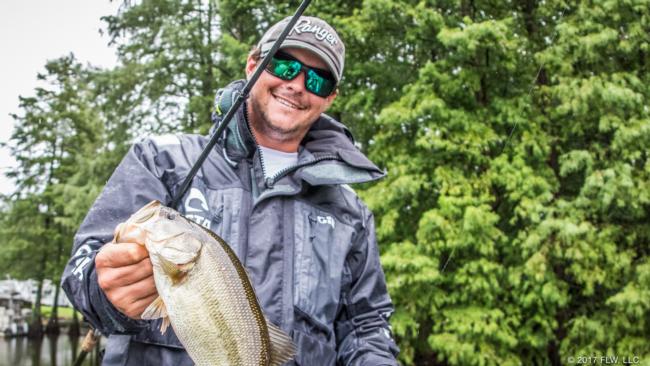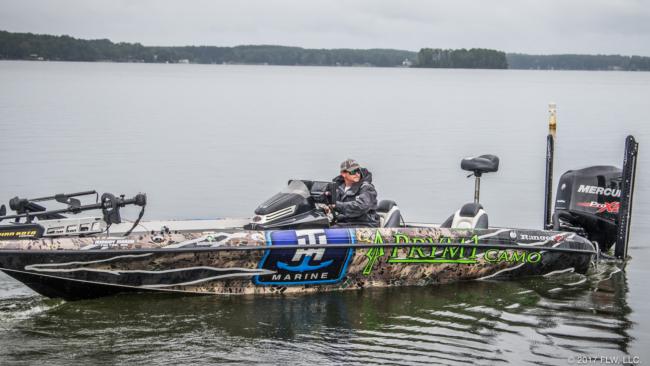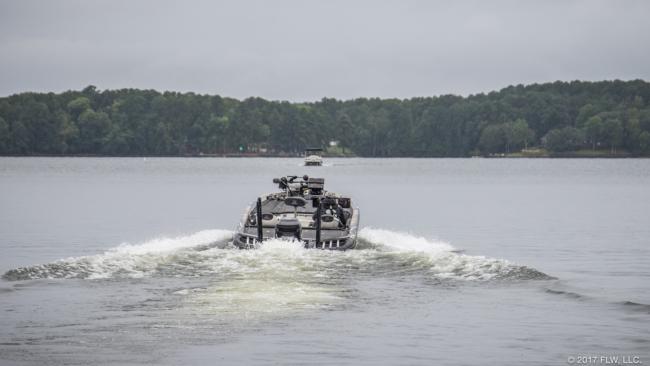At it with Atkins
FLW Tour young gun on a quest for a career and the Cup
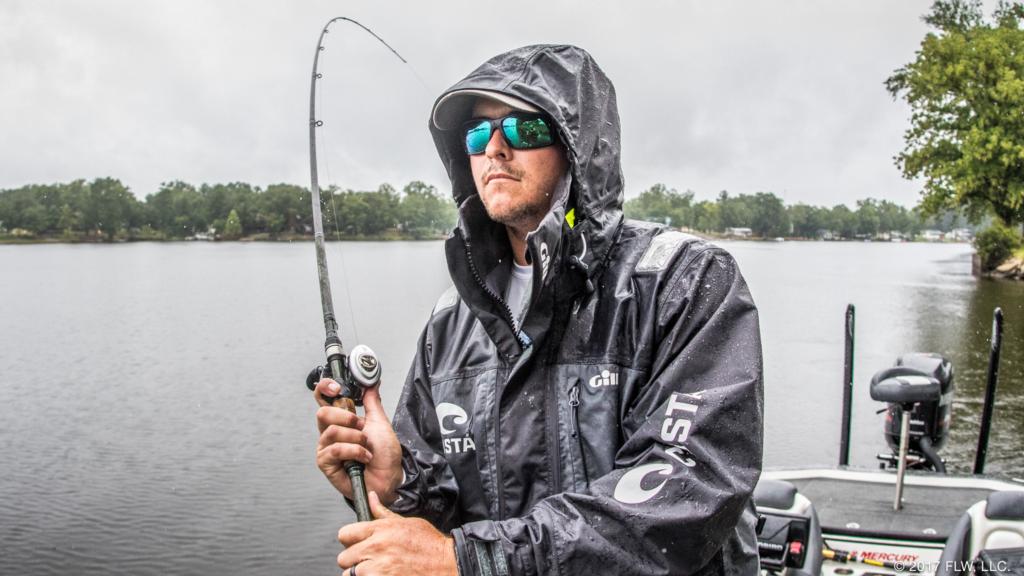
A few sprinkles splatter the windshield when I arrive at Dreher Island State park. It’s 6:30 on the third morning of Forrest Wood Cup practice at Lake Murray, and there’s more rain in the forecast, so I sling my foul weather gear into a pile and wait.
My cellphone rings: Justin Atkins.
I answer, and my host for the day says he’s a few minutes out. He stopped for a biscuit, what with grease and carbs being important fuel sources on days like today, and now he’s headed toward the ramp.
A few minutes later, the runner-up in the 2017 FLW Tour Rookie of the Year race steams into the boat launch area, No. 3 in procession behind his roommates and practice partners, Shane LeHew, who leads the convoy, and Brandon Cobb.
The Millennial trio makes quite the crew. Combined age: 82 years. Combined FLW earnings: $635,651. Combined FLW top 10s: 59.
Their friendship stands for more than just impressive fishing stats, however. They’re examples of FLW’s stair-step approach to climbing the tournament ranks.
Each grew up a bass angler, fishing junior and local derbies before graduating to the FLW College Fishing ranks and, eventually, to the FLW Tour. College Fishing is where Atkins (Mississippi State) and LeHew (UNC Charlotte) first met. When Atkins invited LeHew and Cobb (Clemson University) to room with him at the first Tour stop on Guntersville back in the spring, the coming together of young talent led to a season-long relationship that included sharing fishing information. According to Atkins, the relationship has benefitted each member on the water at some point this season. Now, they’re all three fishing the Forrest Wood Cup, and any one of them has the skills and experience needed to potentially win this thing.
By 7 a.m., LeHew has helped Cobb, still recovering from a broken bone in his foot, get his boat in the water, and Atkins is ready to see what challenge Mother Nature has laid for him on day three of Cup prep. He throttles down and hangs a left around the farthest island at Dreher, pointing his Ranger toward the lower end of the lake.
Up or down the lake?
Between a four-day pre-practice and two days of official practice, Atkins has logged enough hours on Murray that he already feels like he’s on the trail of some decent fish. The problem is he hasn’t figured out how the fish will respond in any weather scenario, nor how reliable his patterns will be over the course of a three-day championship. So first thing on the agenda is to check on a schooling spot he located previously to see how they’re reacting to the morning’s overcast, drizzly conditions.
It’s no secret that bass school over brush, cane piles, points, humps and creek channels on Murray in the summertime, but since Anthony Gagliardi won the 2014 Cup on Murray with a final-day flurry of schooling activity, the surface busters are top-of-mind for many anglers this week. Also, word around the ramp is that the shallow bite is a little “off” this year.
“It didn’t get hot enough to put them up shallow,” explains Atkins. “I know that sounds crazy, but when it gets hot out deep, the oxygen level gets low, and that puts them up in the top part of the water column. They get up there and chase those bluegills.”
Atkins spent most of his pre-practice outing on Murray graphing and looking for bass, and he’s amassed a pretty sizable collection of waypoints marking potential spots. During the first two days of official practice, he split time between fishing shallow on the lower end, which produced basically no good leads, and graphing some of the offshore spots to see which ones have fish.
The first spot he pulls up on this day is one he just happened to stumble into the day before, when he saw some fish bust.
With the trolling motor still stowed and not a rod out on the deck, Atkins pops up and gazes across a long point. One fish shows itself, but then the point goes quiet. He takes a call from his wife, Tessa, a teacher back home in Florence, Ala. Atkins, who was born and raised in Columbus, Miss., unlocks his rod locker and digs out a rod rigged with an ima Little Stik pencil popper while he chats. When the conversation ends, he makes his first cast.
“I caught most of my fish on a [Lucky Craft] Gunfish [in pre-practice and early practice], but you can throw this one [the Little Stik] so much better in the wind it’s unreal,” he says.
He deliberately picks apart the point over about 25 feet of water with long casts, hoping to call up a suspended fish, then idles 100 yards or so up the bank and picks up the bait again. There’s nothing doing here, but Atkins idles around and points out one fish in the top of a piece of cover on his depth finder.
The young pro doesn’t claim to be an expert on blueback herring lakes, particularly largemouth-dominated blueback lakes, but he does have some experience with the nomadic baitfish on spotted bass lakes and knows how to work the bass over with Texas rigs or topwater if they’re suspended.
“The bluebacks have changed the way these largemouths act,” he claims. “They’re definitely not your typical largemouths. Nowhere else in the world are you going to call a largemouth out of 10 feet of water, or at least not on Pickwick [where he lives]. I can’t call a largemouth out of 4 feet of water there.
“They hit so hard when they commit,” he adds. “They cover that 10 or 12 feet like that, so they have a lot of momentum built up. It’s pretty dang exciting.”
Wondering about the weather
Atkins’ biggest concern right now is how the fish will respond if the weatherman is right and rain and cloud cover remain throughout tournament week. He doesn’t expect the schooling activity to be too reliable late into the day, but cloud cover might extend the bite – he’s still not sure. Likewise, up shallow, he thinks cloud cover makes bass more likely to bite a buzzbait, but they’re harder to pinpoint without distinct shade lines.
When he leaves the schooling spot without a bite, Atkins is still unsure on the offshore end, but he’s more interested in staying off his pre-practice waypoints (he plans to scan them again later to see if any have fish) and sampling some new water upstream where he might be able to find some keepers once the schooling tapers off.
He jets back toward Dreher with the Little Saluda River being his target location.
A couple miles later he spots LeHew out on the main lake and veers off course to check in with his buddy.
“You capture any?” Atkins asks.
“Six or seven. How bout you?”
“About 23, 24 pounds.”
The sarcasm is as thick as the cloud cover over Lake Murray, but eventually the young pros get down to business and report on their first stops. It’s about a three-minute break before they part ways.
Another couple miles up the lake (and one selfie later), Atkins spots a Quaker State boat and changes course once more to check in with another pal of his, Scott Canterbury. They exchange a few niceties and a bit of info on the bite and part company just about as fast.
Atkins and Canterbury met about 10 years ago at a Costa FLW Series event on the Columbus Pool of the Tombigbee River. Atkins was a co-angler, and Canterbury was “just Scott” back then.
“We got to be buddies, and we’ve been buddies ever since,” Atkins says. “Dixie [Scott’s wife] calls me her son.”
For such a young pro, Atkins has deep roots in the tournament business.
After he graduated from high school in 2008, Atkins competed on the national stage at the 2008 The Bass Federation Junior World Finals on Lake Monticello in South Carolina, at the same time that 20-something pro Michael Bennett was winning the Forrest Wood Cup right here on Lake Murray. It was the first Cup that Atkins had ever attended, and the lake is now the site of his first Cup appearance.
The next stop for Atkins was a two-year junior college. In 2009, he banked 50 grand for winning the Weekend Series national championship, and eventually stepped up to the Costa FLW Series level, which is when he met his best friend, eventual Bassmaster Classic champ Jordan Lee.
Lee was actually a co-angler in Atkins’ boat in the 2011 Costa FLW Series Southeastern Division opener on Lake Okeechobee. Atkins finished 21st, and Lee took 13th. They shared an epic day of sight-fishing and forged their friendship in a fitting fashion for two up-and-coming bass geeks.
“You spend a day on Okeechobee trying to come back in 6-footers and you either hate each other or become friends,” says Atkins.
Next stop was Mississippi State, where Atkins earned his degree in 2014, and from there he went to work in Florence running Profound Outdoors for well-known bass pro Timmy Horton. That led to another industry gig as a member of a travelling lake-mapping crew, which put some coin in Atkins’ pocket, and when he qualified for the 2017 T-H Marine FLW Bass Fishing League All-American on nearby Pickwick Lake and FLW announced that Guntersville would host the 2017 FLW Tour opener, Atkins lined up two important commitments for 2017: joining the Tour, and marrying Tessa.
Even though Atkins admits that, had he not earned a check early on, he only had the cash to fish three or four events, everything worked out – a blessing, he says. He finished 22nd in the AOY standings, got married a few days after the season finale and moved into his first home.
“There hasn’t been any pressure, though,” says Atkins. “I’m just out here doing what I love.
“I never doubted it’s what I was supposed to be doing. I don’t mean that in an arrogant way. You just know when something feels right.”
Rod No. 2
It’s nearly 8 a.m. before Atkins stops short of the Little Saluda and pulls out another rod. This one’s rigged with a buzzbait made by a friend’s new company called Prototype Lures. Atkins strips off the skirt and threads on a Strike King Menace Grub – his preferred setup for clear water.
He trolls into a small pocket with a natural bank.
“A few of my better shallow bites in pre-practice came on a natural bank,” he says.
The water has a touch more stain to it here, and Atkins believes this is the section of the reservoir where he’ll be able to do some damage up shallow.
“That thing sounds good, don’t it?” he asks as he sloshes the buzzbait over a laydown. A rat can’t resist and clobbers the buzzer. Every bass deserves a photo, so Atkins holds the little bugger close to the camera for a shot.
Fifteen minutes later, another dink tracks the buzzbait off the bank and gobbles it off the surface. Two more blowups – one producing a little bigger splash – tell him to stick with the topwater awhile longer, but four bites still don’t convince him that they’re shallow in numbers.
“This year it seems like the oxygen is good and the fish are still out [deep] and cover-oriented,” he says.
Bass lessons
Atkins zips upstream for a few minutes and zones in on another natural, woody bank. He slings the buzzbait around with short casts, occasionally ticking a branch to create a slight deflection.
Once in awhile a cast clips a limb and hangs momentarily. Back in the day, when he was coming up on the Columbus Pool, Atkins says his close-range casting was much better. Living on Pickwick and making a living bombing casts on the ledges allowed a little rust to form on his “short game.” But it also made him a much better, more well rounded angler, capable of finding and reading schools offshore and catching bass with a variety of tactics.
He’s learned some other important lessons on Tour this season, too. At the Harris Chain in March, Atkins finished 56th, but his co-anglers finished first and second in their competition. Day one was particularly painful. Atkins was on a worm bite, and his co-angler, Tyler Woolcott, put it on the pro with a lipless crankbait. Atkins was onto the lipless bite, too, but his hand was cold that day. When he’d switch back to the worm, Woolcott would call for the net again. The pro finished with 8 pounds, 15 ounces.
On the second day, Atkins says he finally convinced himself to not let his co-angler get in his head, and he saved his tournament with a 14-14 limit.
Then at Beaver Lake, torrential rains and flooding halted all momentum and knocked him out of the Angler of the Year race.
“That was about a career-ruiner for me,” he says. “I’d been catching them all year. Then I go there and finish 132nd.”
The real lesson came a few weeks later, when Atkins refocused and rebounded on the Mississippi River in La Crosse, Wis., and earned a top-10 finish. He’d put the past behind him, and he basically locked up his Cup berth.
Key pockets
Atkins hops around to a couple more spots without a bite.
“It’s so weird,” he says. “I ran into that in pre-practice, where I’d fish several pockets without a bite, then I’d pull into a pocket and get four bites.”
He hasn’t yet dialed in on what pockets are best, but he’s hunting hard and stopping on a variety of spots. But generally, he avoids “developed” banks because he says it’s more difficult to read subtle changes in the makeup of the bank when it’s been manipulated by man.
Atkins would like this pattern to work, but he’s mature enough to know not to force it.
“I prefer to fish shallow,” he says. “I grew up junk-fishing on the river, but I’m not a big fan of clear-water shallow fishing. If I can go down the lake and see them on the graph, I have a lot more confidence I can get them to bite.”
By 9:30, there’s a steady rain falling, and Atkins has fished his buzzbait in at least eight spots. His best sign so far has been a 2 1/2-pounder that followed the buzzbait out to the boat and missed.
When he pulls up to a steep bank next to a creek channel, it only takes a few minutes for a pair of small keepers to eat the buzzbait. Atkins notices a small detail – one he prefers not to reveal – that he thinks might be the key similarity in the spots that have produced bites. He gets another reassuring follower about 100 yards farther down the bank.
Rainy days
Atkins takes his time fishing the latest bank, but eventually the rain strengthens and forces him to take refuge under a bridge. Four days is a long practice period, so a few minutes spent dodging raindrops is a justifiable sacrifice.
He takes the time to dig out a Texas-rigged ribbon-tail worm and pitches it to the end of the riprap causeway on one end of the bridge while he waits, mostly just killing time.
It’s about 25 minutes before the rain lets up enough that Atkins is ready to go again. The worm goes down, and the buzzbait comes back out as he checks the face of the causeway for any life. Nada.
His next stop is a bank lined with riprap and concrete. Atkins isn’t impressed, so he eases across the creek and digs out rod No. 4, fitted with a beaver-style bait, which he pitches a few times around a long wooden dock before swapping back to the buzzbait to dice up a mix of cypress trees and laydowns.
So it goes for the rest of the morning. He runs up a few creeks and tosses the buzzbait at whatever looks good, mixing it up enough to rule out various types of banks and cover. He lands one final keeper that he has to measure to verify as legal, then gobbles down some tuna on crackers before hitting one last spot and hauling me back toward the ramp.
Atkins still isn’t sure about the shallow bite, but he thinks it could get better if conditions change. Overall, the lake is fishing so tough right now that even small keepers on the banks could be worth a healthy payday come the weekend.
“As far as bites go, I think it’s easier to get bites up here,” he says of Murray’s upper end. “But down the lake, there’s no question, if you get a bite it’s going to get put in the box.”
It’s shortly after noon now, and Atkins drops me back at the ramp so I can get dry and get to work. He plans to spend the rest of the day, along with Wednesday’s final practice round, splitting his time between the shallow program and scanning offshore, trying to figure out if either pattern or some combination has the goods to earn him a $300,000 payday.
